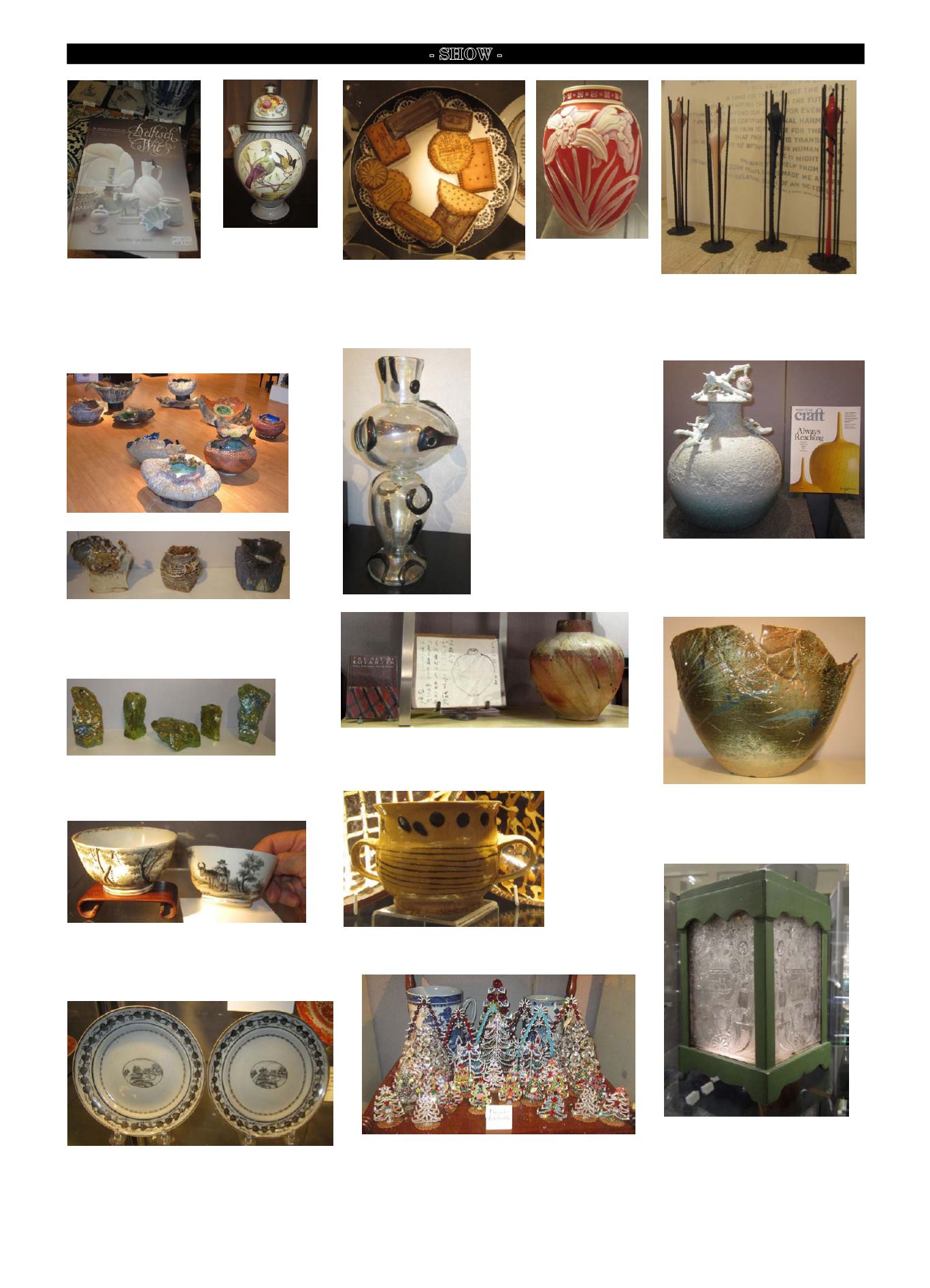

Maine Antique Digest, April 2015 29-D
- SHOW -
☞
Léon-Paul Van Geenen wrote
a book about white Delft that
often appears in Dutch still
life paintings. He sold multiple
copies of the book at $80 each.
Van Geenen said 24 different
factories were making white
Delft, but little of it survives
because it was everyday ware.
Steve Tobin’s small “Bang” pots were priced at $200
each at Iliad. They sold well. To create them, Tobin
explodes shaped clay with firecrackers, adds glaze,
and then fires them. The larger pots, shown on the
floor, are priced at between $8000 and $25,000.
Cameo glass made by
Thomas Webb & Sons
was the most expensive
glass made when it was
new. This daffodil vase
was $29,500 from Leo
Kaplan. It is made of
white, red, and paper-thin
clear glass.
Martyn Edgell
Antiques, Cam-
b r i d g e s h i r e ,
England, asked
$6400 for this
rare
Stafford-
shire
slipware
two-handled ves-
sel, circa 1720,
decorated with
dots and stripes.
Fornasetti cookie plate, $1800 from Paul
Vanderkar, who said he sold a lot of
Fornasetti.
Large Davenport vase
with cover, decorated with
birds and flowers after
plates by Edwards, with a
blue ground, $9500 from
Paul Vandekar of Earle
D. Vandekar of Knights-
bridge, Maryknoll, New
York.
Steve Tobin, a Quakertown, Pennsylvania,
artist, who had a recent exhibition at the
Michener Art Museum in Doylestown, made
these “Cocoon” totems. Made of glass and cast
steel, they were priced at $25,000 each by Iliad,
New York City.
Pablo Picasso (1881-1973),
Fla-
menco,
Fucina degli angeli,
Murano, limited edition number
3/7, $140,000 from Sylvia Powell
of London, who had a booth full
of spectacular rarities.According
to Powell, Egidio Costantini, a
major force in the world of glass-
blowing, who collaborated with
some of the greatest artists of the
20th century, was introduced to
Picasso at his home in Vallauris
in 1954. Picasso was very inter-
ested in the opportunities offered
by glass as an art medium. Their
friendship lasted until Picasso’s
death in 1973. Picasso and Cos-
tantini pushed the limits of cre-
ativity, making pieces that were
seemingly impossible to create
in glass.
Cliff Lee, a porcelain artist from Stevens,
Pennsylvania, was the subject of the cover
story in the February/March 2015
American
Craft
magazine. His lava-glazed vessel was
$25,000.
Chen Yan was born in China but now lives in Flushing, New York.
This vase with the letter and drawing from the person who com-
missioned it was $55,000.
Chen Yan,
The Golden Years
, $200,000.
He wrote in his catalog that he hopes his
“ceramic art might help you to find beauty
in life and a life of beauty.”
Polly Latham of Boston offered these Chinese export por-
celain plates painted with a view of Mount Vernon, show-
ing the slave quarters, that were made for Captain Daniel
C. Bacon of Barnstable, Massachusetts, commander of the
clipper ship the
Gamecock
, 1810-20. They were $2800 each.
Two circa 1810 Chinese export bowls decorated with
the scene of the
Quaker Farmer
, an original sketch by
Mary Hollingsworth Morris that was sent to China and
reproduced on porcelain, $950 each from Polly Latham.
Julia Kunin of Brooklyn went to Hungary and
learned the secret of the Zsolnay eosin glazes and
made these Scholar’s Rock vases. They were $2000
each from Iliad.
This extraordinary lanternwith four extremely
rare marked J. & C. Ritchie lacy pressed win-
dowpanes, Wheeling, West Virginia, 1833-36,
lantern 1840-70, was $37,500 from Ian Sim-
monds of Carlisle, Pennsylvania.
Lynda Willauer of Nantucket, Massachusetts, asked from $45
to $235 for the miniature crystal Christmas trees made in Ger-
many in the early 20th century. The candle trees were $265.










